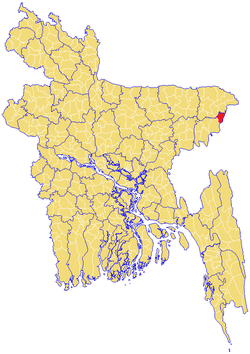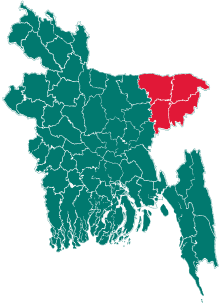Barlekha Upazila
| Barlekha বড়লেখা | |
|---|---|
| Upazila | |
 | |
| Coordinates: 24°42.5′N 92°12′E / 24.7083°N 92.200°ECoordinates: 24°42.5′N 92°12′E / 24.7083°N 92.200°E | |
| Country |
|
| Division | Sylhet Division |
| District | Moulvibazar District |
| Government | |
| • MP (Moulvibazar-1) | Shahab Uddin MP |
| • Chairman (Barlekha Upazila) | Rafiqul Islam Sundor (Awami League) |
| Area | |
| • Total | 315.58 km2 (121.85 sq mi) |
| Population | |
| • Total | 200,674 |
| • Density | 640/km2 (1,600/sq mi) |
| Time zone | BST (UTC+6) |
| Postal code | 3250 |
| Website |
barlekha |
Barlekha (Bengali: বড়লেখা) is an Upazila of Moulvibazar District in the Division of Sylhet, Bangladesh.
History
The Malegarh hillock at Lathu (came to be known later as Shahbajpur), the northern tip of Barlekha Upazila, was shaken up in November 1857 after Indian rebels revolted in Meerut.[1] The soldiers of 34 Native Infantry in Chittagong revolted, looted the armory and treasury and set army barracks on fire. These rebel soldiers, on their way to reach Manipur, pitched their tents at Malegarh. A force of 160 company soldiers under Major Byng, initially reached Protaphgarh (now in India) and then Malegarh on December 19, 1857. In that battle, Major Byng and four other company soldiers lost their lives. The mutineers retreated leaving behind twenty-six rebels including Major Sher Khan and Captain Shamsher Khan. For those who lived long enough to make it to Manipur, they were attacked not only by the company soldiers but also Kuki scouts. Ali Baksh of Chittagong, one of the rebels, was caught and charged of desertion, robbery and revolt. Gonjer Ali of Protapgarh and Zaminder Gous Ali Khan of nearby Prithimpasha were accused of helping the rebels.
Geography
Barlekha is located at 24°42′30″N 92°12′00″E / 24.7083°N 92.2000°E. The area of the upazila is 315.58 km².[2]
Demography
At the 1991 Bangladesh census, Barlekha had a population of 200,674, of whom 50.09% were aged 18 or older (against the national average of 48.52%). Of the population, 49.86% were male (national average of 51.48%) and 50.14% female (national average of 48.52%). The average literacy rate (measured as having 7+ years of education) was 34.6%, against the national average of 32.4%.[3] 70.59% of the population are Muslim, 28.31% Hindu, 0.92% Christian, 0.04% Buddhist, and 0.14% other beliefs. Ethnic nationals include Manipuri and Khasi, who have their own languages.
Manufacturing and minerals
There are 18 tea gardens in Barlekha spread over an area of 64.39 km2, most of which were established by the English tea planters during the time of British Raj. Each garden has its own tea-processing factory. Tea laborers who work in the gardens were brought in the 1800s from outside of Bengal under rather questionable working conditions.[4] Sujanagar of this upazila is famous for producing incense and attar (essence of flowers and Agar tree). For over a century, these have found lucrative markets in Middle Eastern and Far Eastern countries. Cottage industries include weaving, sheetalpati, bamboo and cane work, iron work, and potteries.
At Kesrigul, there is an abandoned oil field of Burma Eastern Oil Company. It was a fully functional oil field but had to be sealed off in 1951 following a disastrous oil flood when crude oil burst out of the well and flooded the surrounding area.
Deposit of radioactive uranium has been discovered in Haragachha Hill at Juri, and an expert team has authenticated its reserve.[5]
Points of interest
Madhav Kunda Falls is a must-see tourist [6] It is Bangladesh's largest waterfall boasting a height of 200 ft (61m) and is set in a lush green Eco-park setting makes for a spectacular viewing.[7] Madhabkunda is surrounded by beautiful tea estates and is full of water lilies. Every year thousands of tourists are drawn to Madhabkunda because of its natural beauty, especially in winter. It is about 5 km from Barlekha railway station, and 350 km from the city of Dhaka. Geologically, this waterfall is in the Patharia Structure and is composed of the rocks of the Bhuban Formation. Local Hindus believe the circular pool where the water falls is a magical place, and many worshippers go there every year. Although the water in the pool is not very deep, several tourists have lost their lives in Madhabkunda by the force of the water.
A 16th-century Mosque located in Loghati village (of Dasher Bazar Union) is an archeological heritage site that continues to attract visitors.
Over 40% of Hakaluki Haor, one of the largest marsh wetlands of Bangladesh as well as of Asia covering a total surface area of 181.15 km2. falls within Barlekha. A very large number of nature tourists come to visit the haor each year.[8] Hakaluki Haor represents a complex wetland system with more than 80 interconnecting beels in a shallow basin formed between the Patharia and Madhab Hills to the east and the Bhatera Hills to the west. The major sources of water are the Juri, Sonai Bardhal and Kushiyara rivers, which traverse the wetland and drain through a single outlet, the Kushiyara River. While the haor itself is a seasonal water body formed during the monsoon, the beels are low-lying depressions of the haor system retaining water even during the dry months of the season. Thus, the haor system is a complex of both lacustrine wetlands (with open water) and palustrine wetlands (marshy – with vegetation), depending on the hydraulic behaviour in different seasons. In rainy season it takes the shape of a sea. Hakaluki Haor is famous for a wide variety of waterfowl as well as wintering migratory birds.[9] Every winter, tens of thousands of guest birds of about 150 species from Siberia and other cold regions flock to the haors. They include Bright and Rose King-duck, Pati-duck, Bali Hash, Lenja, Chity, Sorali, Boikal, Nilshir Piyan, Pantamukhi, Pankouri, Buti-duck, China, Rangamuri, Black-duck, Peributhi, Chokachoki, Giria, Khonjona, Patari, Dolpipi, Water-hen, North-Giria, Dahuk, Patibatan, Common-chill, Cotton-Chill, Gergini, Cottontail, Pintail, Toughed Duck.
Hakaluki Haor presents a unique type of ecosystem as well as a new set of management issues. Most of the local inhabitants are in some way dependent on the wetland for their livelihood. Hakaluki Haor supports one of the largest inland fisheries in Bangladesh. It is one of the so-called ‘mother fishery areas’, i.e. areas where brood, young and juvenile fish aggregate and take refuge during the dry season when the rest of the haor area becomes dry. While the area was once known as a "fishmine", its fish stocks are now increasingly threatened. Hakaluki Haor is on a global level a very important wetland for a wide variety of waterfowl, particularly Anatidae ducks. In the 1960s, the wintering population of ducks was estimated at between 40,000 and 60,000.Every year a lot of birds making their nest in the house of Late Haji Monuhor Ali Master's house. This house became very well known as Masterer Pakir Bari which is a popular tourist attraction to the naturalist. Everyday a lot of local and international tourists visit Masterer Pakir Bari. In Hakaluki Haor threatened species such as Pallas’ Fish Eagle also occurs at the wetland, which is furthermore an important area for reptiles such as freshwater turtles, and for amphibians.[10][11][12]
Administration
Administratively, Barlekha Upazila consists of 8 Unions and 1 Pouroshova[Municipality]/Ward that encompasses 109 Mauzas or Mahallas and 253 villages.[2] The Unions are:[2]
- Barlekha
- Barni
- Dakshin Shahbazpur
- Daser Bazar
- Nij Bahadurpur
- Talimpur
- Uttar Dakshinbhag
- Uttar Shahabajpur
Education
- Siddique Ali High School was established at 1927.
- Patharia Chotolekha (P. C.) High School is Barlekha's educational institution.
- Barlekha Girls' High School was established in the 1960s.
- Muraul high school was established in 1983.
- Dasher Bazar High School
- Dasher Bazar Adarsho College
- ঈদ্গা বাজার বালিকা উচ্চ বিদ্যালয়
- Talimpur Baharpur High School.
- Fokhiro Bazar High School .
- Chandrogram High School .
- Pakshail Adarsho High School
- Barlekha Degree College
- Barlekha Nari Shikkha Academy
- R.K lycum kindergarten was established 1994 [ Top school of barlekha]
Notable residents
Barlekha has produced several outstanding personalities who have excelled in academics, research, creative writing, and social programs known nationally and in some cases globally. These individuals are:
- Dr. Mohammad Ataul Karim, Executive Vice Chancellor & Provost [13] of the University of Massachusetts Dartmouth. Editor, Optics and Laser Technology[14]
- Dr. Abu Nasar M. Wahid, Professor of Economics, Tennessee State University, USA[15] and Editor of Journal of Developing Areas[16]
- Dr. Muhammad B. Zaman, Chief of Cyto-Pathology, Westchester Medical College, New York, USA[17]
- Dr. Muhammad K. Zaman, Associate Professor, Medicine-Pulmonary, University of Tennessee Health Science Center, USA[18]
- Dr. Muhammad Abdus Shukur, Author, Social Activist, Physician, and Founder of Anti-Smoking Movement in Bangladesh[19][20]
- Dwijen Sharma, Botanist and Environmentalist, Winner of Prothom-Alo Book Award[21]
- Muhammad Abdul Halim, Sr. Database Architect and Administrator, State of Georgia, Georgia, USA.[22][23] At 16th[24]
See also
References
- ↑ "Role of North-East Muslims In 1857 War of Independence - - Muslims and 1857 War of Independence -- Latest News about Muslims,Islam".
- 1 2 3 Mustafa Salim (2012). "Barlekha Upazila". In Sirajul Islam and Ahmed A. Jamal. Banglapedia: National Encyclopedia of Bangladesh (Second ed.). Asiatic Society of Bangladesh.
- ↑ "tableS04". 27 March 2005.
- ↑ http://jugantor.us/enews/issue/2011/03/20/news0725.php
- ↑ http://www.beanibazarkontho.com/%E0%A6%AC%E0%A7%9C%E0%A6%B2%E0%A7%87%E0%A6%96%E0%A6%BE%E0%A7%9F-%E0%A6%AF%E0%A7%87%E0%A6%B8%E0%A6%AC-%E0%A6%B8%E0%A7%8D%E0%A6%A5%E0%A6%BE%E0%A6%A8%E0%A7%87-%E0%A6%85%E0%A6%AA%E0%A6%B0%E0%A6%BE/
- ↑ "Enchanting Getaways". Star Weekend Magazine. The Daily Star. Retrieved 2010-11-13.
- ↑ "Archived copy". Archived from the original on 2010-12-29. Retrieved 2010-11-13.
- ↑ "bangladesh travel guide: Hakaluki haor- welcome to water kingdom [ হাকালুকি হাওরে ভ্রমন ]".
- ↑ http://umanitoba.ca/outreach/begcb/pub/presentations/27739254-Environmental-governance-in-Hakaluki-Haor-Bangladesh.pdf
- ↑ "Welcome to CWBMP".
- ↑ http://en.bdfish.org/2010/11/hakaluki-haor-plenteous-beauty-pompous-biodiversity/BdFISH
- ↑ "Archived copy". Archived from the original on 2010-04-17. Retrieved 2010-11-13.
- ↑ "UMass Dartmouth appoints new provost".
- ↑ "Optics & Laser Technology Editorial Board".
- ↑ "Archived copy". Archived from the original on 2010-07-18. Retrieved 2010-11-20.
- ↑ "Project MUSE - Document Not Found".
- ↑ http://www.cblpath.com/medical-operations/pathology-department[]
- ↑ Affairs, University of Tennessee Health Science Center; Office of Academic, Faculty and Student. "UTHSC Faculty facepage : MUHAMMAD K. ZAMAN, M.B.B.S.".
- ↑ মুক্তিযুদ্ধ ও মুক্তিযোদ্ধা [Liberation and Freedom]. Deputy Commissioner Moulvibazar (in Bangla). Archived from the original on 2011-02-27.
- ↑ "Yahoo! Groups".
- ↑ "Dwijen, Mostafa win Prothom Alo Best Book of the Year Award". 13 January 2008.
- ↑ "eProthomAlo".
- ↑ Feuerstein, Steven (18 July 2010). "PL/SQL Challenge: Winners of First PL/SQL Challenge Playoff Announced".
- ↑ Halim, Abdul (26 August 2016). "How to Generate or Create ERD diagram with Oracle SQL Developer- Version 4.0.3.16".
